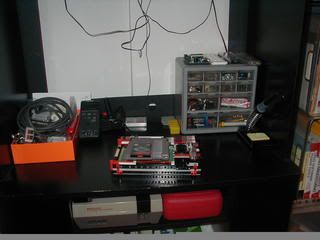I didn't read every post, so sorry if this has already been suggested.
I have built a few robots myself. I would honestly recommend staying away from the simple "put-together'kits (except for Lego Mindstorms), as they offer little reward and don't have the open-endedness to expand with you. I'll Edit some links in.
NOTE!
At least with LegoMindstorms, you can download hacked firmware and develop in Java or Not Quite C when you are ready. And you'll save money on base materials, and won't have to cut any metal, plastic, plexi-glass, or wood. Though the intial investment may be out of your range. Honestly for me to have enough flexibility to build at the size and complexity I wanted, I invested nearly $3,000.00 in Lego Technic Parts/sets, RCX's, Sensors, Pneumatics, motors, compressors, Chain links, gears, wheel sets, beams, pins etc...
Not that you need that much, but I wanted real-size bots. Of course you can also use the lego bricks/beams just to build a prototype frame for actual electronic robotic projects. That's more of what I do today. I have a pic somewhere of my Compaq Presario Laptop Bot, supported on a Lego Platform and some hacked lego sensors/multiplexors. I'll try to find it.
This was my proto-typing soldering station (some Lego Mindstorms books off to the right. I'll have to take a pic, of my entire lego kit today. You can see my Parallax board on top of the gray assorted electronics, & screws/nuts organizer. Not sure why my regulated power-supply is not in the pic.
 QuickLink to FloppyTheRobot
QuickLink to FloppyTheRobot
FIRST!!!... FIND A ROBOTICS ENTHUSIASTS CLUB IN YOUR AREA.
(If you are allowed.)
-These people will be your best source, for getting the right stuff, and the correct knowledge better than any book. Surrounding yourself with people with a higher level of skill, and bank account, will allow you to see where you can take this. You can get hands on experience with cool systems, before you can afford it yourself. Plus, most clubs I have been to are very eager to help you get going with your projects. I'm not sure of your age, so if under 18, just makes sure it's alrigth with your parents and/or perhaps they can attend with you to make sure the club is on the up and up. Can't really be too careful these days.
Micro-Controllers (MC's) - The Brains!!!
Besides Lego, I think the best place to start is learning to program Micro-Controllers. And the best start for that has to be
Parallax. In fact, RadioShack even sells them now. For a better selection and packages order from Parallax themselves or find a quality electronics distributor/retailer near you.
Parallax's offers a wide variety of it's Basic Stamps MC's incuding numerous variations on the Basic Stamp 2. If you are serious about designing programmable bots, with AI, sensors, this is the place to begin. After you get your feet wet with Basic Stamps, you can look into PIC controllers, and more advanced embedded systems programming.
Basic Stamp programing language, is well ummm, is BASIC... very easy to get into, and if you can understand some very simple DarkBasic commands you'll be on your way. I would reccomend getting the a
decent robotics starter-kit that includes "The Board Of education, the softare, cables, book, and dev breadboard. If you can go for the BS2EX and get the one that allows you to mount and dismount it. The integrated one is ok, but you don't want to be tied the prototype board forever. So it makes more sense to have a removable micro-controller chip. So that's your Brains.
It's Alive... But Now Needs Drive!!!
As far as motors. The easiest way to get started is to use servo motors from RC cars, boats, planes. Most servo motors have a notch on them to prevent them from continuosly turning 360 deg. It's not hard to
clip the notch of and modify them to act as a drive motor. The signal processing is also fairly simple. It offers a balnce between speed, and torque. Eventually you'll move up to DC motors, and bigger Power supplies.
NOTE!!!
If you are on a budget and don't want to spend $$$$ on expensive servo's, you can go thorugh peoples trash or garage sales Thrift Shops and pull motors out of many items; including but not limited to, Cassette/CD players, Floppy drives, VCR's etc... There is plenty documentaton on the web, to hack these motors into your projects. Very cost effective!!!!
My Bot "Isn't Smarter Than A Fifth Grader!"
-PIC MC's and Old Intel Laptops to the rescue!
After getting some knowledge in building smaller servo bots, you can move up to PIC MicroControllers, and better drive systems. I've also found that older laptops are quite cheap, and serve as the brains for your bots. At that point you will want to learn about Programming signals to ports such as LPT1, Serial/com, and possibly USB. After gaining some more education, you'll want to be able to communicate with your bot, and even update it's programming wirelessly. There are plenty of integrated Wifi or blue tooth solutions.
I'll try to add some references of links, Resources, Tutorials, & books below.
From Crawling to Walking
As you gain more experience you'll want to study different drive (bipeds, Killoff's platform (360 degree driving mechanism), multi-legged syncing, various steering, track driven, Gearing, Climbing and balancing etc...) mechanisms.
Welcome Mini-Me!
The "creme de la creme" are (COG's) Center Of Gravity Shifting Bi-peds or humanoids. You can spend a lot of time in this area. As well as Arms/grippers, visual & other sensors, voice recognition, GPS and pathfinding algorithms, neural networks, creating appendages with X many dimensions of independent movement/control.
Just try to tackle each subsystem, starting simple and working up.
Good luck, and let me know if I can help you further.
sincerely,
~zenassem
Links/Reference
Home Of Parallax
Parallax Robotics Page
Seattle Robotics.org Modifying A servo Motor
Floppy The Robot Page